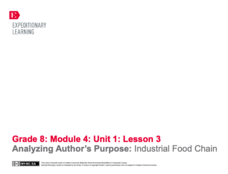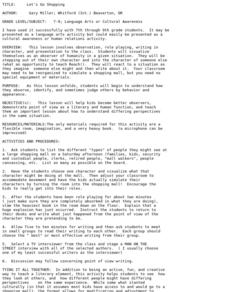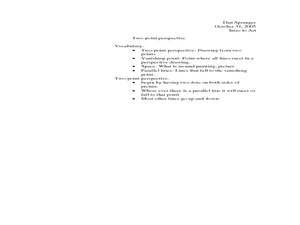University of Pennsylvania
Decoding Propaganda: J’Accuse…! vs. J’Accuse…!
Reading snail mail is a great way to go back into history and to understand others' points of view. The resource, the second in a five-part unit, covers the Dreyfus Affair. Scholars, working in two different groups, read one letter and...
EngageNY
Text to Film Comparison: Taking a Stand at the Jailhouse (Chapters 14-15)
Readers look closely at Scout in chapter 15 of To Kill A Mockingbird. Learners use turn and talk and Analyzing Scout's and the Reader's Perspectives Note-catcher to compare their perspectives to Scout's. They then make a comparison to...
EngageNY
Text to Film Comparison: Bottom’s Transformation
Scholars meet in a drama circle to discuss what they remember from reading A Midsummer Night's Dream Act III, Scene 1 in the last activity. They then take turns reading the scene aloud, stopping to answer questions as they read. Learners...
EngageNY
Analyzing Author’s Purpose: Industrial Food Chain
Using an Author’s Purpose anchor chart, groups examine a variety of text to determine the author's purpose. They then apply what they have learned to The Omnivore’s Dilemma. In pairs, they discuss what the text is about and why...
Scholastic
The First Thanksgiving Feast for Grades 6–8
It's time for the feast! Young historians complete their study of the First Thanksgiving by completing an online activity, watching a slideshow, and examining a First Thanksgiving timeline. After answering text-dependent questions to...
K20 LEARN
The History of Spoken Word Poetry: Historical and Cultural Perspectives In Literature
Spoken word poetry, more than almost any other form, reveals the historical and cultural perspective of the poet. High schoolers listen to various spoken word poems, select one to research in-depth, and then apply what they have learned...
Thoughtful Learning
Adjusting Your Writing Voice
"Yo, what's up?" "Nuttin!" While such a dialogue might be appropriate between friends, it would be ill-advised in more formal situations. A mini-lesson asks young writers to consider how to adjust the voice they use to bring their...
Newseum
Media Ethics: Fairness Formula Starts With Accuracy
As part of a study of media ethics, young journalists apply a fairness formula to news reports. They look at accuracy, balance, completeness, detachment, and ethics to determine if the reporting is fair.
Penguin Books
Educator's Guide: The Da Vinci Code by Dan Brown
Dan Brown's The Da Vinci Code is filled with secrets. Help readers find the clues, solve the riddles and puzzles, and unwrap the mysteries with a six-page guide that includes before, during, and after reading discussion questions and...
Penguin Books
A Teacher's Guide to the Signet Classic Edition of Emily Bronté's Wuthering Heights
Sibling rivalry! Revenge! Ill-fated love! Wuthering Heights has it all! Lead readers through a study of this massive, poignant tale with the help of a 22-page teacher's guide. The guide includes a list of characters and their family...
GoSoftWorks
GoSkyWatch Planetarium for iPad - The Astronomy Star Guide
Digital compass alignment enables navigation of the skies with true orientation at any time. Just point to the sky or "aim for the stars!" This application acts as a virtual telescope, allowing you to zoom in on any object that is...
Virginia Department of Education
Freshwater Food Chains
What's in the water? Encourage your class to further explore this question and learn about pond ecosystems, food chains, and food webs as they complete this hands-on activity. They view the environment from a new perspective...
Curated OER
Seeing Both Sides of an Issue
Students examine global issues from different perspectives. In this communication skills lesson, students participate in a classroom activity that requires them to take stances on issues and then consider the support of other...
Curated OER
Creating an Oral History--Who Tells the Story?
Explore the difficulties in compiling an oral history with this lesson plan. Young researchers conduct interviews and consider how point of view changes various accounts of a single incidence, resulting in conflicting information. They...
Curated OER
If You Lived at the Time of the Civil War.
Students investigate major characters of history that are represented in children's literature. They conduct research using a variety of resources and each character is put into a class book as a presentation. The character includes a...
Curated OER
Let's Go Shopping
Students explore how to become better observers, demonstrate point of view as a literary and human function, and learn an important lesson plan about how to explain differing perspectives in the same situation.
NorthEast Ohio Geoscience Education Outreach
Ecosystems and Change
Pairs of ecologists select an animal and investigate an ecosystem from its point of view. This simple lesson involves Internet research and putting together a presentation of collected information.
Curated OER
Intro to Art
Young scholars explore illusions by drawing and viewing images in class. In this art perspective lesson, students analyze a skeleton outline drawing which demonstrates the ability to draw in a two point perspective. Young scholars...
Curated OER
The Telling: A Thanksgiving Story
students use literature to compare and contrast different points of view on the first Thanksgiving.
Curated OER
100 Years War and Joan of Ark
What events led up to the Hundred Years War? In small groups or pairs the class discusses several critical thinking questions and then writes a fictional dialogue that depicts both an English and a French point of view.
Teacher Vision
The Wampanoag Indians: A Thanksgiving Lesson
Spark some lively conversation about American holiday traditions and debunk accepted notions about the first Thanksgiving at the same time. After reviewing the mainstream version of the Thanksgiving story with your class, offer some...
Curated OER
Revolutionary Advertising?
Students explore and examine the 40th anniversary of Ernesto Che Guevara's execution and his image as an international symbol of revolutionary values. They then interpret the iconic Che image from a variety of different points of view....
Curated OER
Making Faces
Students analyze facial expressions on artifacts. In this artifacts lesson, students examine facial expressions on artifacts. Students draw a face with an expression of their choice.
Curated OER
Cartoons for the Classroom: Government Snooping, Different Views
For this current events worksheet, learners analyze political cartoons about the collection of government intelligence and respond to 3 talking point questions.























